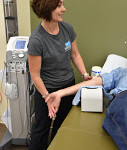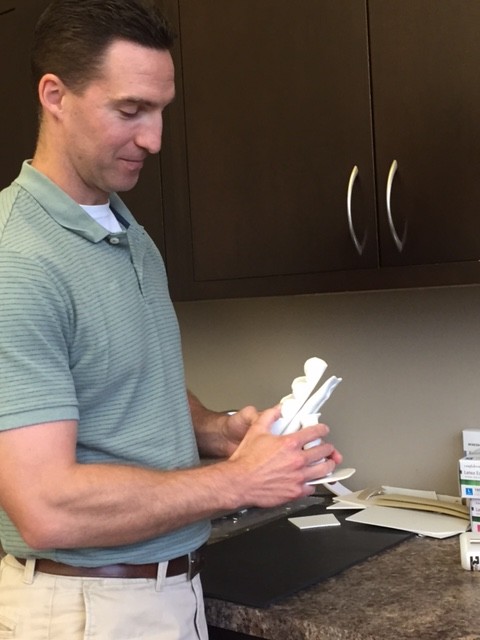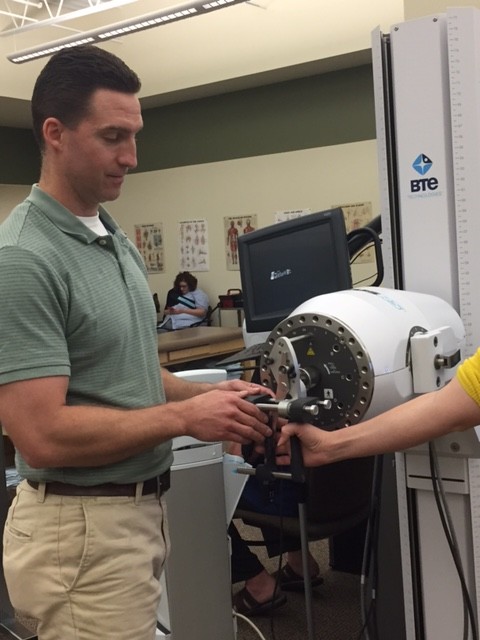April is OT month….. No, not OT as in what happens at the end of regulation time at a sporting event, and not OT as in being paid time and a half, OT as in Occupational Therapy.
Occupational Therapy can be beneficial to a wide range of people from toddlers to golden agers and is provided in a variety of settings. Occupational therapy in the orthopedic setting can be monumental in helping you achieve the highest level of function as quickly as possible following an upper extremity injury. You may not have a great understanding of what OT is, but keep reading and you will get a glimpse of why this specialty is unique and so important. Here are some of the BENEFITS OF…
OT vs. PT
You may be thinking “Why should I do occupational therapy instead of physical therapy? What is the difference between these two?” Occupational Therapy is a specialty that is often misunderstood or misinterpreted. While PT and OT do have many similarities, it is the practical knowledge that is specific to the upper extremity that sets them apart. Just to clarify, the upper extremity includes everything from your shoulder to your fingertips.
Physical therapists are trained to treat conditions from head to toe and are able to treat the upper extremity but occupational therapists specialize in treating only the upper extremity. The knowledge base an OT has is specific to upper extremity conditions and is so refined that they can tailor your rehab program to meet your exact needs and expedite your recovery. If you are suffering from a condition involving your shoulder, elbow, wrist, or hand, occupational therapy could be recommended to help you achieve the maximum outcome.
Seeing a Certified Hand Therapist
Now that you’ve got a basic understanding of what an occupational therapist treats, it’s important that we emphasize an OT’s expertise may not end there. An occupational therapist can become a Certified Hand Therapist, which is the gold standard among therapists. The American Society of Hand Therapists was organized in 1975 and in 1991 the first hand therapy certification exam was administered to grant the title “Certified Hand Therapist.”
Becoming a CHT is not easy. To be eligible for the certification exam a therapist needs to have been licensed for five years and have over 4,000 hours of direct practice in hand therapy. The difficulty of the exam can be seen in the 61% pass rate and the fact that there are only 6,228 Certified Hand Therapists in the world. At the Orthopedic and Shoulder Center, our occupational therapists, Jason Richards and Kim Rhoda, are both Certified Hand Therapists. The title “Certified Hand Therapist” can be slightly misleading- a CHT can treat, and specializes in more than just hands! A CHT will also promote evidence based practice- he or she has an obligation to stay up with current evidence and research to provide the most efficient care to return you to the highest level of function as quickly as possible.
Custom Splinting in Orthopedics
An added benefit of having an occupational therapist on site in an orthopedic setting is their ability to provide custom splinting. Our occupational therapists have specialized training in custom splinting so they can provide a variety of braces that can specifically address your needs. For example, a static progressive splint may be used to help regain motion quicker and more efficiently or a dynamic splint may be used to provide a better stretch with constant tension to increase flexibility. Our therapists use Delta Casting ® because they are removable and allow for the therapist to create a “wear” schedule. A “wear schedule” allows for splint/cast removal to allow for icing, bathing, or itching, to accommodate swelling or discomfort, and to monitor skin breakdown. At the Orthopedic & Shoulder Center our therapists work closely with Dr. Li to determine the most efficient and functional splint that will minimize loss of function and mobility and maximize healing.
Using the BTE Rehab Equipment
BTE Rehab Equipment is a functional piece of equipment that provides a unique component to therapy- therapy through simulation. The BTE allows our therapists to customize settings and resistance levels so patients can train on sport specific activities or perform job simulation tasks. When we have muscle weakness we tend to compensate and overuse other muscles which can then lead to further injury. Our therapists can tailor a program on the BTE to address deficits and retrain you to perform movements with proper form and mechanics. This will help decrease the potential for re-injury. Some examples of activities that can be simulated on the BTE are swinging a bat, throwing a ball, climbing a ladder, shoveling, and using a steering wheel. By using the BTE, strengthening and mobility exercises can be disguised behind activities that are fun and can allow for more creativity in your plan of care.
Occupational Therapy at the Orthopedic and Shoulder Center
We often don’t realize just how much we use our arms and hands throughout the day until we have pain or discomfort or maybe even lose the ability to complete certain tasks. At the Orthopedic and Shoulder Center we have a team of two CHTs and one certified occupational therapy assistant who will design a treatment plan that can address your functional deficits in a way that is fun but also therapeutic. Instead of training you to adapt to the deficit they will provide treatment to help you overcome the deficit. Their extensive training will lead to better outcomes and help you put the FUN back in FUNctional!



